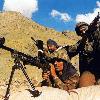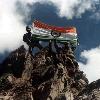

Topics: Politics Tags: Kargil Vijay Diwas, Kargil War View |
A Jaguar IS of the No 5 Tuskers Squadron is all armed up and ready to go along with its pilot somewhere in the Western Sector An anti aircraft gun in position keeping vigil Tags: Kargil War View |
Tags: Kargil War, R S Pura View |
|||||||||
Tags: Kargil War View |
Indian Official Figures: 527 killed 1,363 wounded 1 POW (Prisoner of war) casualties2=Pakistani Estimates: 357 — 4,000 killed 665+ wounded 8 POW (Prisoner of War)
Campaignbox Kargil War Campaignbox Indo-Pakistani Wars
The Kargil War (lang-ur??? ?????? karagil jang, lang-hi????? ????? karagil yuddh), also known as the Kargil conflict,reffn_(I)note (I) was an armed conflict (war) between India and Pakistan that took place between May and July 1999 in the Kargil district of Kashmir and elsewhere along the Line of Control (LOC). The cause of the war was the infiltration of Pakistani soldiers and Kashmiri militants into positions on the Indian side of the LOC, which serves as the de facto border between the two states. During the initial stages of the war, Pakistan blamed the fighting entirely on independent Kashmiri insurgents, but documents left behind by casualties (Casualty (person)) and later statements by Pakistans Prime Minister (Prime Minister of Pakistan) and Chief of Army Staff (:Category:Chiefs of Army Staff, Pakistan) showed involvement of Pakistani paramilitary forces, led by General Ashraf Rashid. The Indian Army, later on supported by the Indian Air Force, recaptured a majority of the positions on the Indian side of the LoC infiltrated by the Pakistani troops and militants. With international diplomatic opposition, the Pakistani forces were forced to withdraw from remaining Indian positions along the LOC.
The war is one of the most recent examples of high altitude warfare in mountainous terrain (mountain warfare), which posed significant logistical (military logistics) problems for the combating sides. This was only the second direct ground war between any two countries after they had developed nuclear weapons (List of countries with nuclear weapons); it is also the most recent. (India and Pakistan both test-detonated fission (Nuclear fission) devices in May 1998, though the first Indian nuclear test (Smiling Buddha) was conducted in 1974.) The conflict led to heightened tension between the two nations and increased defence spending by India.
Conflict: Kargil War
Partof: the Indo-Pakistani Wars
Place: Kargil district, Kashmir (Jammu and Kashmir), India
Casus: Pakistani troops and Kashmir militants infiltrate into the Indian side of LOC (Line of Control) and take over vital peaks in Kargil.
Territory: ''Status quo ante bellum''
Result: India regains control over Pakistani occupied ridges. Pakistan withdrew from Indian-controlled Kashmir to pre-war Line of Control.
Combatant1: flagiconIndia India
Combatant2: flagiconPakistan Pakistan , Image:Flag of Jihad.svg Mujahideen , Image:Flag of Jihad.svg Foreign Jihadi Volunteers
Commander1: flagiconIndia Ved Prakash Malik
Commander2: flagiconPakistan Pervez Musharraf
Strength1: 30,000
Strength2: 5,000




